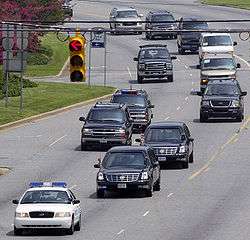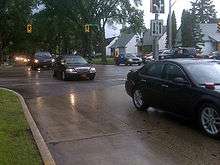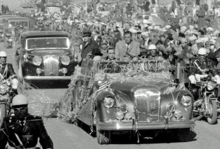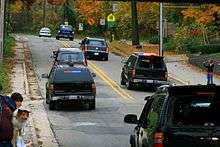Motorcade

A motorcade, or autocade, is a procession of vehicles. The term motorcade was coined by Lyle Abbot (in 1912 or 1913 when he was automobile editor of the Arizona Republican), and is formed after cavalcade on the false notion that "-cade" was a suffix meaning "procession". In fact, there is no such suffix in either French or Latin, although -cade has now since become a productive suffix in English, leading to the alternative names carcade, autocade, and even Hoovercade (after J. Edgar Hoover). Eric Partridge called the name a "monstrosity", and Lancelot Hogben considered the word to be a "counterfeit coinage". The original suffix in cavalcade is actually "-ade".[1][2][3]
Uses of motorcades
Funerals
A funeral cortege is a procession of mourners, most often in a motorcade of vehicles following a hearse.[4]
Protests and demonstrations
Motorcades can be used as protests and demonstrations.[5] A large, organised, group of vehicles will travel a busy route at very slow speed in order to deliberately cause traffic disruption. This is a tactic most often associated with protest groups that have access to many large vehicles, such as truckers and farmers. An example is the 2005 UK protests against fuel prices.[6] As part of the Euromaidan protests in Ukraine in November 2013—February 2014, the sub-movement that made use of car processions as the means of protest was called the Automaidan.
VIPs
Motorcades can be used to transport a very important person, usually a political figure. Such a procession consists of several vehicles, usually accompanied by law enforcement support and additional protection to ensure the safety of the people in the motorcade. Motorcades for heads of government and heads of state can consist of dozens of vehicles, those being armoured cars, SUVs, and police motorcycles and cars leading the way and following.
Traffic diversions
Depending on the size of the motorcade and who it is carrying, routes may be completely blockaded from the general public. For security, this is common with motorcades for heads of state or government.
Gallery
 Funeral motorcade of Russian patriarch Alexy II in 2008
Funeral motorcade of Russian patriarch Alexy II in 2008- Australian prime ministerial motorcade in Canberra, 2009
 Motorcade for Queen Elizabeth II, en route to CFB Winnipeg, 2010
Motorcade for Queen Elizabeth II, en route to CFB Winnipeg, 2010
President of the United States
The motorcade for the President of the United States comprises twenty to thirty vehicles; in addition to the president, the motorcade may carry his or her spouse, members of the press, security, White House officials, and VIP guests. The major members travel in armored vehicles, typically specially configured limousines. The motorcade contains several armored vehicles, a USSS Electronic Countermeasures Suburban, a counter-assault team, and Secret Service agents. When called for, a hazardous materials team precedes the motorcade on alert for potential hazards.
A police presence precedes the beginning of the presidential motorcade. These cars and motorcycles usually drive ahead to clear the way and block traffic.[7]
The motorcade for the president is made up of two parts, the first being the "secure package".[8] In the event of an emergency, the secure package separates from the rest of the group.[8] It includes two limousines heavily guarded by local law enforcement and Secret Service, with all cars driven by professional drivers.[8]
The second part is made up of vans that transport White House staff members and selected members of the press. In the rear is the WHCA Roadrunner communications van – which provides the primary communications path via satellite, allowing bi-directional voice, data and streaming video – an ambulance, and additional police vehicles.[8]
Motorcade routes are selected by Secret Service agents in cooperation with local police forces. Escape routes are also established in the event of an emergency.[8]
Gallery of presidential motorcades
 Calvin Coolidge (in top hat) arrives to dedicate a park in Hammond, Indiana, 1927
Calvin Coolidge (in top hat) arrives to dedicate a park in Hammond, Indiana, 1927 Franklin D. Roosevelt in New Orleans, 1937
Franklin D. Roosevelt in New Orleans, 1937 Harry S. Truman leaves Boca Chica Field in Key West, Florida, with Cecil C. Adell (center), and William D. Leahy, retired Chief of Staff to the Commander in Chief, 1951
Harry S. Truman leaves Boca Chica Field in Key West, Florida, with Cecil C. Adell (center), and William D. Leahy, retired Chief of Staff to the Commander in Chief, 1951 Dwight D. Eisenhower in Kabul, 1959
Dwight D. Eisenhower in Kabul, 1959
 Richard Nixon in Berlin, 1969
Richard Nixon in Berlin, 1969 Following Gerald Ford and Leonid Brezhnev on a tour of Vladivostok, 1974. Photo by David Hume Kennerly.
Following Gerald Ford and Leonid Brezhnev on a tour of Vladivostok, 1974. Photo by David Hume Kennerly. Jimmy Carter leaving Three Mile Island, 1979
Jimmy Carter leaving Three Mile Island, 1979 Motorcade following the inauguration of George W. Bush, 2001
Motorcade following the inauguration of George W. Bush, 2001 Funeral motorcade for Ronald Reagan in Simi Valley, California, 2004
Funeral motorcade for Ronald Reagan in Simi Valley, California, 2004 George W. Bush in Ada, Michigan, 2008
George W. Bush in Ada, Michigan, 2008- Barack Obama in Baghdad, 2009
See also
References
- ↑ Valerie Adams (1973). Introduction to Modern English Word-formation. Longman. pp. 188–189.
- ↑ John Ayto (2006). "motorcade". Movers and Shakers. Oxford University Press US. p. 45. ISBN 9780198614524.
- ↑ Henry Louis Mencken; Raven Ioor McDavid & David A. Maurer (1963). American Language: An Inquiry Into the Development of English in the United States. Knopf. p. 222.
- ↑ Gove, Philip B (1984). Merriam-Webster's Dictionary of Synonyms. Merriam-Webster. p. 640.
- ↑ Doug Bound (1994). "Nonviolent Direct Action and the Diffusion of Power". In Paul Ernest Wehr; Paul Wehr; Heidi Burgess; Guy M. Burgess. Justice Without Violence. Lynne Rienner Publishers. ISBN 1-55587-465-7.
- ↑ Morris, Steven (2005-09-17). "Fuel protesters defy police as convoy crawl jams motorway". The Guardian. Guardian News and Media. Retrieved 2008-01-12.
- ↑ Beam, Christopher (November 29, 2006). "What's in a presidential motorcade?". Slate.com. Retrieved 2008-05-20.
- 1 2 3 4 5 Selingo, Jefferey (September 26, 2003). "Driving; Fed Up With Traffic? Get Behind the Wheel in a Motorcade". The New York Times. Retrieved 2008-05-20.
External links
| Wikimedia Commons has media related to Motorcades. |